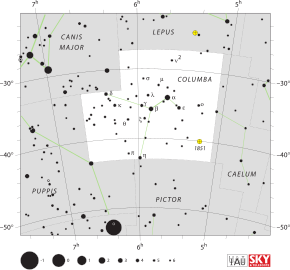| Constellation | |
 | |
| Abbreviation | Col |
|---|---|
| Genitive | Columbae |
| Pronunciation | /kəˈlʌmbə/, genitive /kəˈlʌmbiː/ |
| Symbolism | the dove |
| Right ascension | 05h 03m 53.8665s–06h 39m 36.9263s[1] |
| Declination | −27.0772038°–−43.1116486°[1] |
| Area | 270 sq. deg. (54th) |
| Main stars | 5 |
| Bayer/Flamsteed stars | 18 |
| Stars with planets | 1 |
| Stars brighter than 3.00m | 1 |
| Stars within 10.00 pc (32.62 ly) | 0 |
| Brightest star | α Col (Phact) (2.65m) |
| Messier objects | 0 |
| Meteor showers | 0 |
| Bordering constellations | Lepus Caelum Pictor Puppis Canis Major |
| Visible at latitudes between +45° and −90°. Best visible at 21:00 (9 p.m.) during the month of February. | |
Columba is a faint constellation designated in the late sixteenth century, remaining in official use, with its rigid limits set in the 20th century. Its name is Latin for dove. It takes up 1.31% of the southern celestial hemisphere and is just south of Canis Major and Lepus.
- ^ a b "Columba, constellation boundary". The Constellations. International Astronomical Union. Retrieved 27 February 2014.